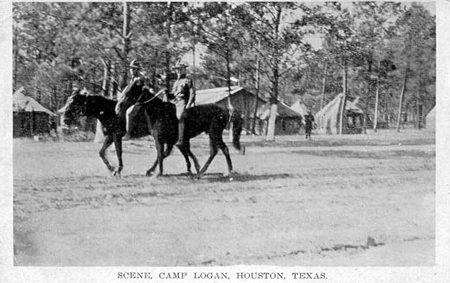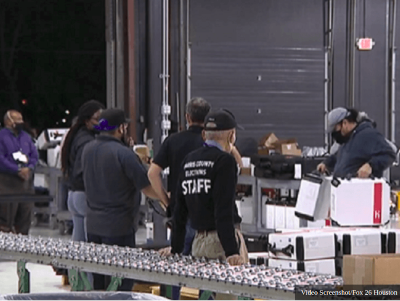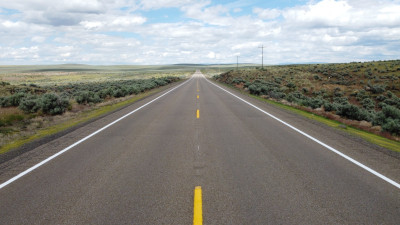Camp Logan, Texas: 1917
 Memorial Park is to Houston what Central Park is to New York City. It is our haven in the woods in the heart of Houston, Texas. Many joggers, runners and walkers hit the park's trail daily to make the three mile loop. I know this park well. In my past life as a criminal court judge, I took to the gravel trail for my daily run, as later did my kids. But what people may not know is the rich history that lies beneath their feet. Much of Memorial Park is located on the grounds of a historical WWI military facility--Camp Logan.
Memorial Park is to Houston what Central Park is to New York City. It is our haven in the woods in the heart of Houston, Texas. Many joggers, runners and walkers hit the park's trail daily to make the three mile loop. I know this park well. In my past life as a criminal court judge, I took to the gravel trail for my daily run, as later did my kids. But what people may not know is the rich history that lies beneath their feet. Much of Memorial Park is located on the grounds of a historical WWI military facility--Camp Logan.
Camp Logan was an emergency training center that was established when the U.S. entered WWI.
After declaring war on Germany, The War Department, now known as the Department of Defense, sought out Harris County, Texas for its moderate climate and Houston's newly opened ship channel.
These elements made it a prime spot to train young American "doughboys'' to go "over there'' to fight in the Great WWI in Europe. Two military installations were built: Camp Logan for the Army and Ellington Field for the Army Air Service. The camp provided shelter and training to thousands of soldiers from all over America from 1917-1919.
Set up like many other army camps in the United States, Camp Logan's primary function was turning young American boys into fighting men. Tens of thousands of National Guard soldiers were trained for duty in France. The soldiers that trained at Camp Logan entered camp straight out of civilian life and found themselves in intense combat preparation.
Tear gas and explosives were used to simulate the conditions on the front lines. But a new type of warfare was harder for the soldiers to imagine--trench warfare. The trenches were bloody, muddy, cruel and under constant attack. History shows how brutal and costly the trench war was.
Even with all the training at Camp Logan , soldiers were not fully prepared for life in the trenches.
To help the soldiers cope with the wounds and harsh reality of war, the commission on Training Camp Activities enlisted the help of several nationwide service organizations like the YMCA, Red Cross, American Library Association, Knights of Columbus, Jewish Board of Welfare and others. Through these private organizations the soldiers had entertainment, counseling, religious services, athletic programs and more.
The kindness of the local Houston community surrounding the camp did a lot to support the men of Camp Logan as well.
With the thousands of men at Camp Logan , the Camp was not without its problems. A conflict by soldiers with local police in 1917 resulted in the death of four police officers, three African American soldiers and ten local civilians after a riot.
After the war, the Camp continued to serve vital functions. In 1919, it was used as a hospital for wounded soldiers coming back from Europe. It also served as a unit of the City of Houston's health care system until 1923.
Catherine Mary Emmott wrote to the Houston Chronicle advising the city to "buy some of the land and turn it into a park in memory of the boys.'' Her efforts led the way in turning the land into a park. Thus Memorial Park--a memorial to the ones who were trained in Texas to fight in Europe.
Emmott's efforts did not fall upon deaf ears. William C. Hogg, son of Texas Governor Jim Hogg, bought two tracts of the former Camp Logan site and sold it to the City of Houston. That May, the City of Houston officially established a park in remembrance of the WWI soldiers who trained there.
Today, Memorial Park includes a golf course, bike paths, tennis courts, baseball fields and a nature center. It is an attraction for runners, walkers and joggers of all ages. The grounds are now a training area for athletes rather than a training area for soldiers.
It is estimated that almost 1,000 Camp Logan soldiers gave their lives during the Great WWI and over 6,200 were wounded.
The Logan soldiers served with distinction in combat in the forest and trenches of Europe. Seventy-five of the African American soldiers trained at Camp Logan from the 370th Infantry were awarded the French Croix de Guerre and 12 received the U.S. Army's Distinguished Service Crosses for their acts of valor.
Memorial Park, as it is appropriately named, has begun a project to commemorate the doughboys who trained at Camp Logan by planting trees in their honor. The series of trees will be lined up like columns of soldiers in an area called "Memorial Groves.'' This section of the park contains the highest number of Camp Logan remnants, artifacts and WWI memorabilia.
It is vital that communities know their history.
The work being done for "Memorial Groves'' at the park is an appropriate way to see that history and honor the memory of Camp Logan and the young warriors it produced.
Texas has had a long history of supporting and uplifting America's military. The history of Camp Logan is our own. Camp Logan should be remembered just as it is--a memorial for the soldiers who trained on Texassoil before they fought on foreign soil 100 years ago. Of the Logan soldiers, some served and returned, some served and returned with the wounds of war and some served and did not return. Memorial Park is a memorial for them all. As we approach November 11th--Armistice Day, now Veterans Day--the end of WWI, it is with deep gratitude that we honor the men of Camp Logan, Texas.
And that's just the way it is.








